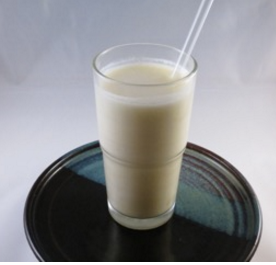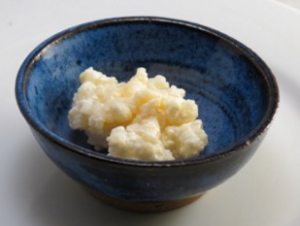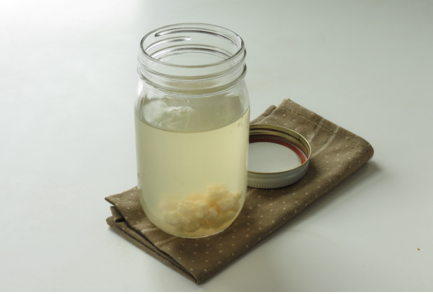10 Mar Kefir: The Probiotic “Feel Good” Drink
This blog was written by Leda Scheintaub. Leda Scheintaub is the author of Cultured Foods for Your Kitchen: 100 Recipes Featuring the Bold Flavors of Fermentation. She is also the author, with Whole Foods Encyclopedia author Rebecca Wood, of The Whole Bowl: Gluten-Free, Dairy-Free Soups and Stews. Leda works with authors to turn their visions into books; she recently had the pleasure of working with Natalie Jill on her forthcoming book Natalie Jill’s 7-Day Jump Start – Unprocess Your Diet. You can visit Leda at ledaskitchen.com. Leda and her husband, Nash Patel, run Dosa Kitchen, a farm-to-truck Indian eatery based in Brattleboro, Vermont.
Kefir: The Probiotic “Feel Good” Drink
 “Probiotics” is a hot word these days, for good reason. As you unprocess your diet, eating probiotic-rich foods is one of the best ways of keeping your gut happy. It will help you tackle digestive and immunity issues or avoid them in the first place. You can get probiotics from a pill, but the best probiotic punch comes from food, in particular fermented foods, also known as cultured foods.
“Probiotics” is a hot word these days, for good reason. As you unprocess your diet, eating probiotic-rich foods is one of the best ways of keeping your gut happy. It will help you tackle digestive and immunity issues or avoid them in the first place. You can get probiotics from a pill, but the best probiotic punch comes from food, in particular fermented foods, also known as cultured foods.
Fermenting is a way of getting maximum nutrition from your food: You start with an already healthy food, and through the process of fermentation, nutrition is increased and beneficial bacteria are produced. That means your food now contains living superfood qualities. Pure probiotic magic! Plus, the flavors in fermented foods elevate what you eat in a most incredible way.
I fell in love with fermentation a decade and a half ago, and I enjoy cultured foods with most every meal, from the pickle alongside my gluten-free wrap to the kimchi that spices up my plate and the miso that goes into my soup. Last year I published a book with Rizzoli titled Cultured Foods for Your Kitchen: 100 Recipes Featuring the Bold Flavors of Fermentation.
When we think of cultured foods, we typically picture yogurt with the “live cultures” seal on the label. Kefir, a tangy and slightly effervescent fermented milk beverage, is another fantastic source of dairy-based probiotics. In fact, kefir contains a greater variety of strains of probiotics than yogurt, with the probiotics in kefir working to directly colonize your gut. No wonder the Turkish translation of “kefir” is “to feel good”!
Continue to enjoy your yogurt (Natalie’s and my favorite is Greek yogurt because it’s high in protein, low in calories and sugar, and incredibly creamy), and add probiotic variety to your diet with kefir. Because kefir is drinkable, you can turn to it for a grabbable breakfast or anytime energizing snack option. And it makes a smart smoothie base.
As with yogurt, the live cultures in kefir help break down the lactose, so many people with lactose intolerance are able to drink kefir. But for those of you who completely avoid dairy, there are nondairy kefir options.
Ready to give kefir a try? The simplest way is to buy a bottle in the store (you’ll typically find it near the yogurt display), preferably one made with organic milk and definitely without added sugar, and start your new “feel good” drinking routine. Feeling brave? You can make your own!
How to Make Your Own Kefir
Making your own kefir—a probiotic cultured milk drink—takes just a couple of minutes of active time, saves you money over buying kefir from the store, and puts you in control of the quality ingredients you use. Read about the amazing health benefits of this superdrink here.
Kefir Starter
Before you get started, you’ll need to find yourself a kefir starter.
A kefir starter, or kefir grains, look a little like tiny  cauliflower florets, and when you mix them into milk, the milk ferments into kefir. It’s that easy. Once you’ve got your starter, you can use it over and over again to make endless batches of kefir, with the starter multiplying every time so you can share it with friends and family.
cauliflower florets, and when you mix them into milk, the milk ferments into kefir. It’s that easy. Once you’ve got your starter, you can use it over and over again to make endless batches of kefir, with the starter multiplying every time so you can share it with friends and family.
GEM Cultures and Cultures for Health are two reliable sources for kefir starters (or find a friend who is already making kefir and ask her to set you up with some!)
Homemade Kefir
Equipment
1-quart wide-mouth jar or pitcher
Small mesh strainer
Ingredients
4 cups organic milk
About 1 tablespoon kefir starter
- Pour the milk into a wide-mouth jar or pitcher.
- Add the kefir starter.
- Cover the jar with a clean dish towel and secure it with a rubber band, or simply loosely cover with the lid (do not secure the lid).
- Leave at room temperature away from sunlight for 12 to 48 hours, depending on the season and kitchen temperature (it ferments more quickly when it’s warm), until thickened and tangy to your liking.
- Strain your kefir into another jar, stirring with a spoon to push out all the liquid.
- Drink your kefir. Or use it as a base for a smoothie. If you find your kefir too tart, sweeten it with a little stevia or a small amount of honey or maple syrup.
- Cover any remaining kefir and place it in the refrigerator, where it will keep for several weeks.
- Take the starter left in the strainer, put it in another jar of milk (no need to rinse them first), and make another batch of kefir in the same way.
Note: If you aren’t ready to make another batch of fresh kefir right away, store the starter covered in milk in a small jar in the refrigerator for up to a week; change the milk every week or two until you’re ready to start making kefir again.
Nondairy Kefir Options: If milk isn’t what you’re drinking, try almond milk kefir or coconut water kefir. Note that you can use your kefir culture repeatedly for nondairy kefir, but it will not multiply.
Almond Milk Kefir: Substitute an equal amount of

Coconut Water Kefir
almond milk. It will culture quicker than other milks, normally in less than 12 hours. It will be thinner than dairy kefir and will separate; give it a shake before drinking.
Coconut Water Kefir: Substitute an equal amount of coconut water. Other than turning the coconut water a little cloudy, it won’t change much in appearance. Coconut kefir tastes less sweet than plain coconut water and has a slight tang to it.
Buy Cultured Foods for Your Kitchen and bring probiotic-rich ferments into your life today!
